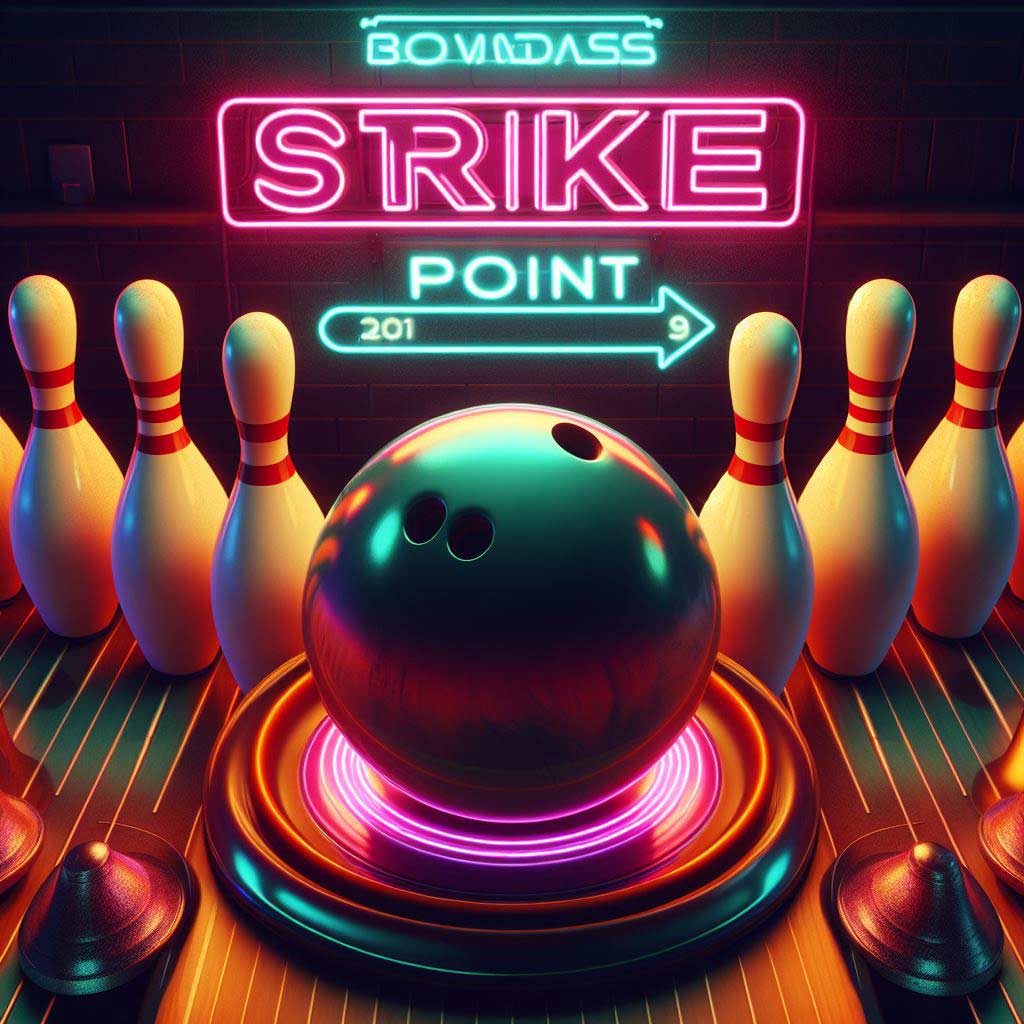Bowling pins crashing to the lane floor after a fierce roll of your bowling ball. There’s nothing quite as satisfying as timing your approach and release perfectly to hit that true strike right in the bowling ball’s sweet spot.
As over 70 million Americans who bowl regularly can tell you, there’s no denying that throwing strikes is the most coveted score in the sport of bowling. Even non-bowlers recognize the excitement that comes from a bowler throwing that complete strike.
But if you were to ask a random person on the street exactly why strikes are so valuable in bowling, they might struggle to get much further than “You knocked all the pins down with one roll!”
It’s a fair assumption that a strike would simply amount to 10 points in a frame since there are 10 pins set up equaling one point per pin. However, strikes end up contributing far more to your total score than just those 10 face-value points.
Let’s analyze the mathematics behind strikes, spares, gutter balls, and open frames to understand exactly why experienced bowlers so intensely chase the almighty X on their score sheet.
A Brief History of Scoring in the Sport of Bowling
First, it helps to understand a little bit about the history of scoring rules and mechanics in bowling so we can appreciate why strikes ended up becoming disproportionately the highest-scoring opportunity. After all, the scoring framework didn’t materialize out of thin air.
The current standard system of scoring in bowling dates back over 100 years. Historians note the rules first took form around 1895, although variations existed for several decades still to follow based on the preferences of different regions and bowling groups.
The original concept though followed the same model as it does today – bowlers roll three balls in each of the 10 frames that compose a complete game. They tally up points based on the number of pins toppled over in each roll or frame.
Where do strikes derive their high value from in this framework? It has to do with the number of rolls per frame and how strikes create additional rolls compared to other shot outcomes.
When you throw a strike – knocking down all 10 pins on the first ball of a frame – you get to move on to the next frame after just one roll instead of three. You fulfilled the objective of clearing the frame using only the first roll rather than needing the second and third attempts as well.
This means you essentially earn back two extra rolls that you can apply elsewhere thanks to not needing them to finish off that frame that you threw the strike in.
Therefore, in classic bowling scoring fashion, the value of the strike comes not only from the 10 pins knocked over but the compounding effect it produces in earning additional rolls.
Let’s move forward now over 100 years to examine exactly how strikers, spares, splits, and gutter balls translate numerically using modern scoring mechanics.
Scoring Breakdown – Points Earned from Strikes vs. Spares
Alright, time for the mathematical breakdown to determine exactly how much a strike earns a bowler compared to other types of shots in the game. Let’s start first by establishing the value of a spare and its comparative worth to strikes.
A spare refers to when a bowler knocks down all 10 pins throughout two rolls in a frame rather than just the first throw. For example, knocking down 7 pins on the first ball and then cleaning up the remaining 3 pins on the second roll.
So with a spare, the bowler uses both their first and second rolls before moving on to the next frame. This differs from a strike where the bowler moves forward after just their initial roll, earning back two extra rolls.
Here is exactly how strikes and spares each amount to and contribute to your bowling score algebraically:
- Strike – A strike earns 10 points (number of pins knocked down) plus a bonus of whatever the bowler rolls on their next two rolls across the next frames. For example, if you roll a strike and then follow up with 7 pins and 2 pins across frames two and three, you would earn 10 + 7 + 2 = 19 points for that initial strike frame.
- Spare – A spare earns 10 points for knocking down all pins plus a bonus of whatever is rolled on the bowler’s next roll. Using the example above, if the bowler had instead picked up a spare in frame one and then threw 7 pins and 2 pins in the following two frames, their score would be 10 + 7 = 17 points for frame one where the spare occurred.
You can see the immediate difference between a strike having the capability to earn at least a few points higher than a spare based solely on the additional roll. This nicely showcases the intrinsic value making strikes ultimately more lucrative in bowling’s scoring framework.
Now let’s expand on why strikes hold even greater disproportionate upside through the multiplier effect on your score as you throw more per game. This is where we truly see strikes separate themselves mathematically from all other types of bowling shots.
The Multiplier Effect – How Strikes Amplify Your Score
Any bowler who has been in the flow and thrown multiple strikes in a row can speak firsthand to the intoxicating rushing of adrenaline it produces. The crowd going wild after strike three, four, even five in a row is electric for bowlers and spectators alike.
Beyond just the satisfaction and glory from other bowlers though, this multiplier effect also dramatically impacts your overall game score potential. The more successive strikes thrown, the higher your compounding score soars.
Let’s take a quick example to showcase strikes amplifying scoring power:
A bowler throws three strikes consecutively in frames one, two, and three. In frame four they knock down nine pins on the first roll but miss picking up the spare by only knocking down one pin on their second roll.
Here is how their score from those initial frames add up: Frame 1: Strike = 10 (point for pins) + Frame 2 score Frame 2: Strike = 10 + Frame 3 score Frame 3: Strike = 10 + Frame 4 first ball (9 pins) Frame 4: 9 pins (first ball) + 1 pin (second ball)
Total score from those frames = 10 + 10 +10 + 9 + 1 = 40 points
Notice how the score grows exponentially thanks to each additional strike adding another 10 plus the next two rolls onto the previous strike’s score. Now imagine if the bowler threw yet another strike in frame four – it would add the strike’s 10 pins plus the next two frames rolls onto the prior three strikes, ballooning the total score more and more.
This is why the coveted “turkey” in bowling – three strikes in a row – is so meaningful to bowlers beyond just that nice accomplishment and challenge to string together. The multiplier scoring effect leads to serious points that alone might lock up a whole bowling game victory if done early on.
Now that we’ve covered exactly why strikes are more valuable shot for shot versus any other bowling hit, let’s examine the maximum upside…
What’s the Highest Score Possible from 12 Strikes?
So we know strikes effectively earn double the rolls and resulting bonus points compared to any other type of shot in bowling. But what does that look like if a bowler were to exclusively throw nothing except strikes for all 12 possible frames?
The answer is rolling a “perfect 300 game” that every bowler dreams and talks about but very few ever accomplish firsthand. Converting every single frame to strikes results in the absolute maximum points output – 36 rolls turning into 300 points.
Here is exactly how the mathematics work out frame by frame to tally 300 points from 12 total strikes:
- Frame 1: Strike – 10 points
- Frame 2: Strike – 10 + Frame 1 bonus roll points = 20 points
- Frame 3: Strike – 10 + Frame 2 bonus roll points = 30 points
- Frame 4: Strike – 10 + Frame 3 bonus roll points = 40 points And so on…each additional strike tacks on another 10 plus the accumulated score from all previous strikes as we move through all 10 frames
- Frame 10: Final strike – 10 + accumulated points from all prior strikes = 300 points!
So theoretically, 12 strikes rolled consecutively frame after frame gives the bowler 36 rolls (three balls per each of the 12 frames) to build up the utter highest score possibility in bowling – a perfect 300 game!
Now in reality, while 12 strikes consecutively represent the upper limit, bowlers can also throw what’s known as a “perfect game” by having a variation of their strikes across the later frames.
For example, going strike, strike, strike in frames 1-3 but then nine spare in frame four leaves the chance for three more strikes in frames 5-7 while still having bonus balls to convert. This would also result in 12 strikes ultimately and a 300-point total.
However, competitive bowlers who have thrown 300s and others going for that top goal will tell you stringing together strikes early is the hardest route.
Having to keep the release and power perfect late in the game with the title on the line amps pressure dramatically. Either way, you get there though, 12 strikes and an untouched lane for 36 rolls is the bowler’s scoring nirvana!
Wrapping Up the Immense Value of Bowling Strikes
We’ve walked through why strikes represent the pinnacle of bowling glory both visually knocking down all pins plus mathematically holding a scoring advantage over any other type of shot. Only one single bowl touching every pin to sweep the deck!
To quickly recap:
- Strikes earn the bowling a bonus roll multiplier effect unrivaled by any other hit
- Successive strikes increase scoring exponentially thanks to compounding frames
- 12 total strikes amount to the maximum perfect 300-game score
- Yet all bowlers must also capitalize on earning bonus points after strikes by converting their additional rolls
It takes skill, finesse, timing, strength, and a little bit of luck too for bowlers to consistently throw strikes frame after frame. But that challenge combined with the high-value strikes hold makes it no surprise bowlers obsess over chasing them down!
So next time you ask any bowling fan “How much is a strike in bowling?” make sure you have all the facts above ready to roll. The X on the scoresheet holds extra meaning representing the bowler’s ultimate weapon and highest possible points per frame.
Frequently Asked Questions
Is a strike worth 20 points?
No, a single strike is not automatically worth 20 points. A strike earns 10 points for knocking down all 10 pins plus a bonus of whatever is scored on the next two balls rolled. So a strike could end up being worth 20 points if the next two rolls also scored 10 points.
How much is 3 strikes in a row worth?
Three successive strikes in a row is called a “turkey” and each builds on the previous strike’s score. For example, the first strike earns 10 plus the next two rolls, the second strike takes that total and adds another 10 plus the next roll’s points, and so on.
How many points is two strikes in a row?
It depends on what is scored after the two strikes. Assuming no other pins were knocked down, the minimum points would be 20 (10 per strike). With more pins knocked down, the score increases with bonuses.
How much are spares and strikes worth?
A strike is worth 10 pins plus your next two rolls. A spare is worth 10 pins plus your very next roll. So a strike holds potential to score higher bonus points.
How do you get 20 points in bowling?
You could get 20 points from a strike followed by knocking down 10 pins on your next two rolls. Or by picking up two spares consecutively each worth 10 plus the next ball.
How many points is 12 strikes?
12 strikes in a row is a “perfect game” worth 300 points – the maximum possible score. Each adds 10 pins plus the accumulated score from all previous strikes.
What is 4 strikes in a row called?
In bowling, four consecutive strikes is called a “hambone”. It continues the turkey (3 strikes) for 4 total.
What is 9 strikes in a row called?
There is no special bowling nickname or moniker for 9 strikes in a row. The bowler would be working on a “9-count” heading into the 10th frame.
What is 8 strikes in a row called?
Like with 9 strikes, there is no special term for 8 consecutive strikes. The bowler would be on the verge of a very high score if they could finish with more strikes or pick up spares.





